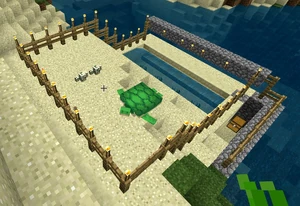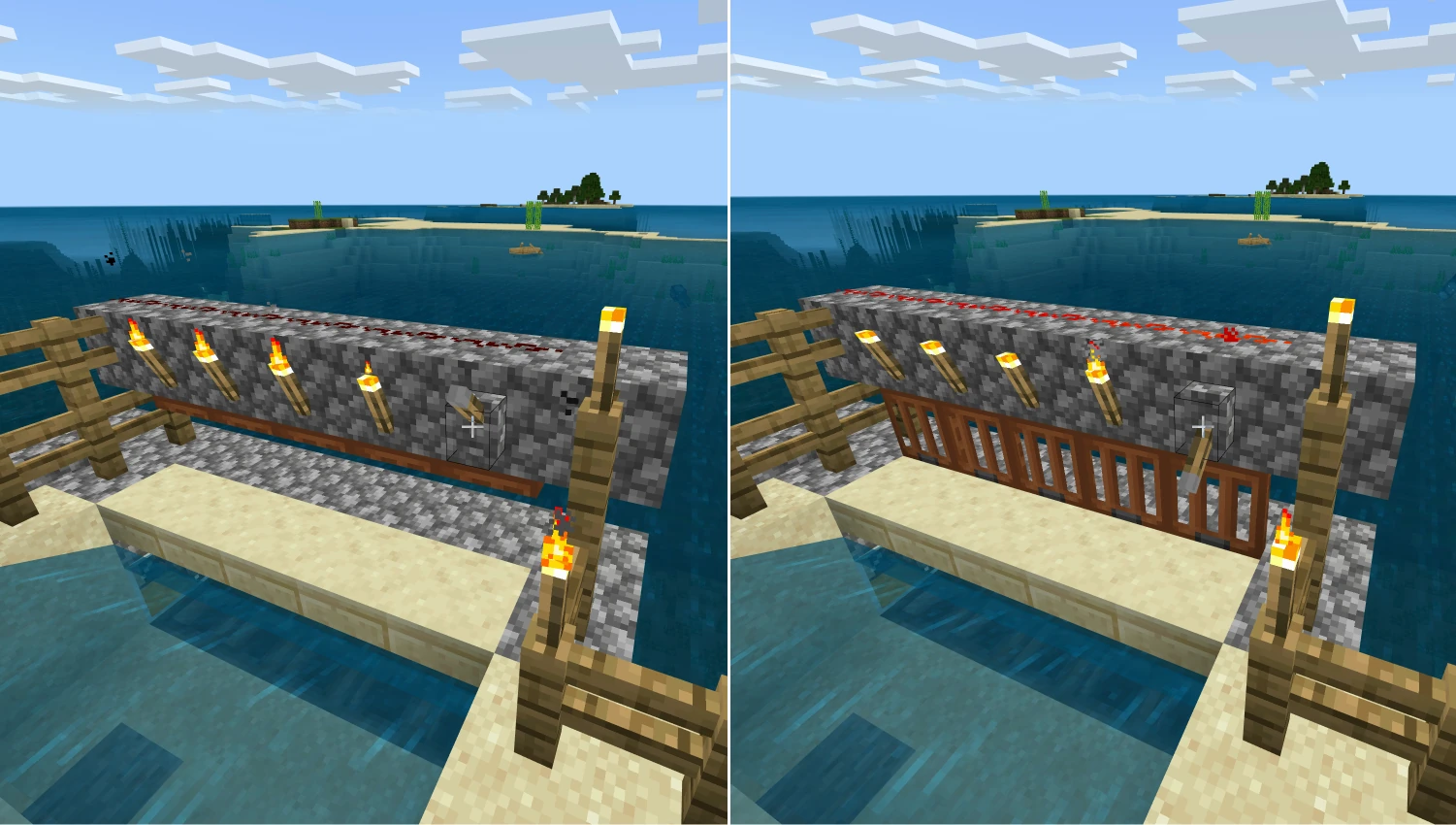How to Make a Minecraft Turtle Farm TUTORIAL
How to Make a Minecraft Turtle Farm

A turtle subcontract, turtle beat out subcontract, or scute subcontract is a means of convenance turtles to harvest scutes, which are used to craft a turtle helmet. In addition to having the aforementioned defense value as an iron helmet, it has greater durability than an iron helmet, and grants the water breathing status result for 10 seconds. Likewise, a turtle helmet can be enchanted with Respiration for an additional fifteen seconds underwater. Another utilize for a turtle farm are potions of the turtle primary, an extremely powerful potion that can exist used for PvP. This tutorial describes a turtle farm that can reasonably be congenital in survival mode.
Contents
- ane Location
- 1.1 Hunting for eggs
- 1.2 Breeding turtles
- two Construction
- 2.1 Blueprint considerations and preparation
- 2.2 Preparing the beach
- ii.3 Building the farm
- 3 Managing the farm
First you demand to obtain turtle eggs. At that place are two approaches: Hunting for eggs, or convenance turtles. In either case, one time you locate turtle eggs, immediately build a argue around the eggs to protect them from being trampled past undead mobs while you lot build the farm.
Hunting for eggs
Find a beach in a warm sea biome, or a beach side by side to a warm land biome such as desert or savanna, where turtles take already laid eggs. You lot need turtle eggs to kickoff the farm working and producing. You lot must build the subcontract around eggs already laid past turtles or use a tool enchanted with silk touch to pick upward eggs then place them in your farm. If yous don't take a silk-touch tool, only build your farm effectually the eggs.
If yous manage to detect plenty of eggs in the wild, you don't really need to build a farm. Selection up the eggs with a silk touch tool, then identify them in a safe location for hatching and harvest scutes as the turtles mature.
You may exist lucky plenty find two turtles breeding on a embankment or splashing up sand in preparation for laying eggs, or notice eggs already laid.
Convenance turtles
If y'all see turtles instead of eggs, look around the nearby beaches to see if they've laid eggs. If you don't notice eggs, use sea grass to lure two of them onto a beach, feed them ocean grass to get them to breed, and so follow them to where they want to lay their eggs. Only one of the two turtles lay eggs. If one looks slightly fatter later mating, follow that one. If you tin can't tell, attempt to keep track of both turtles until you see one of them splashing sand. A 2d thespian in the same earth can assistance.
If you don't build around eggs, but instead lure turtles with ocean grass into your subcontract and and so breed them at that place, they won't lay their eggs in your farm. The significant turtle always swims back to its home beach to lay the eggs. You need eggs in your subcontract before your farm can piece of work.
Design considerations and training
In that location are many variations of turtle farms. At the most basic level, one needs
- An expanse of sand for the turtles to spawn
- A volume of water in which the baby turtles can grow
- A means of protection against undead mobs from finding and destroying the turtle eggs. It is important for the subcontract to exist well-lit to forestall mobs from spawning inside it, and to use fencing or other barriers to make the farm inaccessible to hostile mobs that may arroyo from state or from the h2o.
Optionally, it's also good to have several hoppers and a chest. If yous're attempting a survival mode build, you lot may first desire to build a survival-mode iron golem farm to collect enough iron to craft as many hoppers every bit yous demand, too as fe tools, weapons, and armor.
During construction, it may be a practiced idea to have a bed and shelter nearby to get some occasional slumber, to prevent phantoms from spawning while you work.
Preparing the beach
When fencing off the beach surface area, be sure to go out at least one block of clearance from the contend, and so that hostile mobs cannot climb into the farm. Likewise, remember that turtles need to spawn on sand, so be sure to replace non-sand blocks on the beach with sand blocks.
It's a good thought to include one or more fence gates, so you can get in and out of the subcontract hands. Without a gate, yous shouldn't be able to climb inside (if you can, then so tin can mobs).
Alternatively, the actor can place a carpet on a fence block so they can jump in and out easily. Mobs cannot practise this.
Clearing the beach surface area typically yields enough blocks of sand to build the necessary structure in the sea, from which the farm can exist hollowed out. If you have a bucket, and so don't be concerned about preserving the water in the subcontract, considering you can ever re-fill the necessary h2o blocks with buckets of water scooped from the ocean.
You don't need to brand the beach flat, particularly if the turtle eggs have already been laid on an elevated surface. Simply exist sure that the shoreline blocks are level with the water, and avoid steps that are two blocks high, so that the turtles may get upwards onto the beach easily.
Building the subcontract
Side view cross-department of blocks used in a basic turtle subcontract. A body of water is on the left and spawning beach on the right. Spillover from the water source blocks is not shown, and neither are mob-protection features or the collection chest at the finish of the row of hoppers.
The bones turtle subcontract shown as a side-view cross-section in the diagram on the correct can be congenital easily in survival mode. This slice tin be repeated any number of times to create a farm of whatever width, preferably at least 5 blocks broad (8 blocks wide is a applied size), with a chest at the cease of the line of hoppers along the bottom. The farm in this diagram is designed to be built in survival mode, and let turtles to go in and out freely. It has these features, from left to correct:
- A bulwark (the block floating in the air) to foreclose mobs from entering the farm from the sea while allowing turtles to pass underneath
- A solid seawall to go on the bounding main or body of water out
- A top slab that allows big turtles to bridge the gap betwixt the barrier and the water cake, allowing them to reach the beach when entering, or attain the seawall when leaving
- Hoppers to collect the scutes dropped by baby turtles as they abound
- Water source blocks bundled to create a waterfall toward the hoppers. Turtles cannot easily swim confronting current, so it is important to take a bridge of at to the lowest degree two water source blocks on each layer to provide a region of still h2o in which the turtles can motion and climb out onto the embankment.
- A sand beach to let the turtles to spawn
In addition to these features, other features not shown in the diagram should also be included:
- A chest to collect the scutes at the end of the line of hoppers
- An extra hoppers may be used to position the chest outside the farm
- To avoid using an extra hopper, the chest tin can be put right inside the side wall with a glass cake above information technology, because chests tin can be opened with a transparent block above
- Fencing or barriers all around the farm
- Lighting to prevent mobs from spawning in the farm
The eggs hatch after a few twenty-four hours-night cycles. Later the turtles hatch for the starting time time, y'all're basically washed. Equally each baby turtle grows up, it drops a scute and leaves. You tin advance their growth by feeding them sea grass. The turtles eventually render on their own to your farm to lay more than eggs.

You can modify the barrier by installing a gate made from trapdoors under the bulwark. The trapdoors can be operated manually, or you can lay a line of redstone grit on top of the barrier with a lever somewhere to ability all the trapdoors at once. This tin can be used to go along adult turtles from leaving until you accept fed them and got them to mate. A meaning turtle needs to render to the water before returning to the embankment to lay eggs. She may do this by returning to the water in the farm, and you might demand to attract her back out onto the embankment with seagrass. Otherwise, let them go out the farm and you can induce them to re-enter it later. A significant turtle fits under the trapdoors when open.
If you venture away from your subcontract further than the despawn range (128 blocks in Java Edition, 44-128 blocks in Bedrock Edition depending on simulation altitude), the turtles in the farm despawn if you lot have not interacted with them past offering them seagrass.
If you wish to have the turtles exit the farm area, you can add temporary slab (to each module) to the correct of the current slab. Still, identify information technology on the bottom of that cake rather than the top, to provide a staircase of sorts. Merely do this when you take all adult turtles in the farm, and go to the outside with some seagrass to attract them to the outside. In one case they've left, remove the temporary slabs, to preclude future baby turtles from also escaping on them.
DOWNLOAD HERE
How to Make a Minecraft Turtle Farm TUTORIAL
Posted by: brownyouserainvid40.blogspot.com
Kommentare
Kommentar veröffentlichen